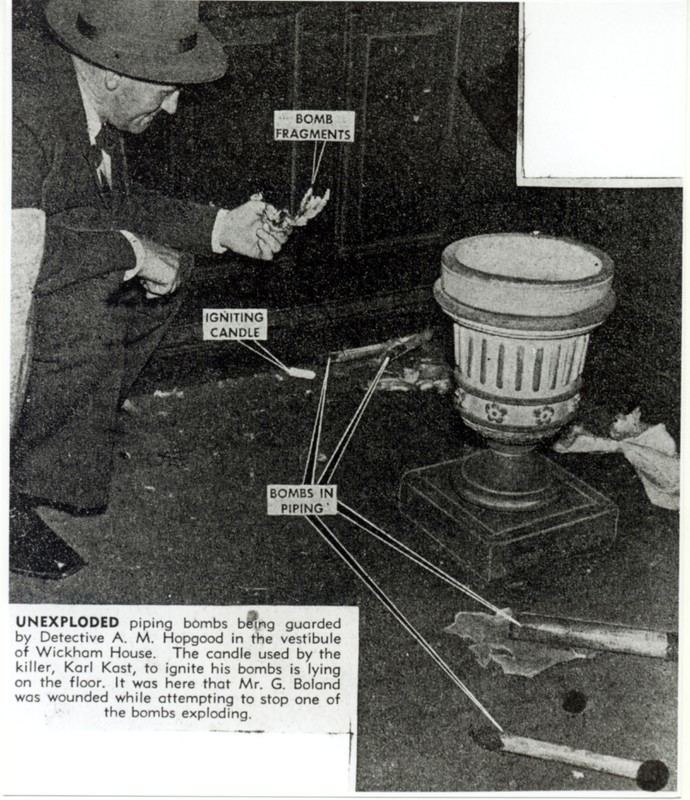Name Karl Kast | ||
 | ||
Siegfred Karl Kast (c. 1916 – 1 December 1955) was a German immigrant to Australia who shot dead two doctors and unsuccessfully attempted to detonate a bomb in Wickham Terrace, Brisbane, before committing suicide.
Contents

Early years
Little is known about Kast before his arrival in Australia. Kast jumped ship from the German freighter Halle in Brisbane two months before the outbreak of World War II, he claimed he was fleeing the tyranny of Adolf Hitler’s Nazi regime. The files in the National Archives record his story as told to Australian military authorities. Kast claimed that as a member of the illegal Social Democratic Party, he was arrested and sent to Bavaria to face the Political High Court.
He managed to jump from the train en route, and took refuge in Czechoslovakia. After returning to Germany to make contact with an illegal cell of the Party, he was again arrested and imprisoned in a concentration camp as a political prisoner. After his release, he managed to escape Germany via a ship from Hamburg to Australia.
With the coming of war, Kast was interned as an enemy alien in Gaythorne in Queensland and later in Tatura camp in Victoria. He escaped four times from the internment camps, only to be caught shortly after and re-interned each time. He also joined compatriots in digging an escape tunnel under a hut at Tatura. Camp officials discovered the tunnel before its completion, but not before the would-be escapees dug 10 metres towards the camp’s boundary wire.
Kast appealed against his internment and argued his case in a letter to the Director-General for Security in Canberra. He claimed "100% loyalty" to Australia, and said that he was looking forward to standing "shoulder to shoulder with the people who treated me from the very first day as one of their own". An intelligence officer suggested that Kast was "an individual and something of a philosopher". Some of his former workmates from a Queensland sugar mill signed a petition calling for Kast’s freedom.
In 1944, Kast was released from internment to join the Civil Alien Corps, a wartime construction unit run under military discipline. He was assigned to the Allied Works Council in the Northern Territory, a civilian manpower organisation that implemented defence projects.
He was suspected of malingering when he refused to work on health grounds. A high ranking Allied Works Council officer wrote of Kast: "It appears to me that the whole of the actions of this member are directed at causing the maximum inconvenience to the Allied Works Council and therefore to the Commonwealth".
Kast’s years of wartime incarceration were followed by a decade of free-booting adventure in Queensland’s north before his eventual deterioration into a paranoid killer.
He became in turn a salesman in Victoria, Adelaide and Brisbane and a mine worker at Mount Isa, before heading for the still frontier-like country north of Cairns. Here he mined wolfram, scratched for tin, and trapped fish for the growing Cairns market before turning would-be farmer. He taught himself the use of explosives as he cleared a block of virgin scrub on the shores of Bessie’s Inlet.
At one time he thought of becoming a Torres Strait pearler; at another he contemplated life as a gold prospector in what was then the Australian mandated territory of Papua New Guinea. Along the way he became first a permanent resident of Australia and then a naturalised citizen. His 1944 pledge that he "would do no harm to this country" was, sadly, to prove untrue.
Incident
On Thursday, 1 December 1955, Karl Kast, carrying a home-made bomb shot dead two doctors, Dr Arthur Vincent Meehan and Dr Andrew Russell Murray and wounded Dr Michael Joseph Gallagher and George Boland. A fourth doctor, Dr John Lahz was severely traumatised due to the incident. Dr Michael Gallahger, Kast's first victim, was shot in his offices in Wickham House. Kast then ignited three bombs in the foyer of the building. George Boland, a patient of one of the doctors in the building, attempted to stub out the bomb only to have it explode and maim his hand. Kast then went to Ballow Chambers, around hundred metres down Wickham Terrace, where he shot Dr Andrew R Murray and attempted to apprehend Dr John Latz, who escaped.
Following his rampage, Kast locked himself in the office of Dr Lahz, within Ballow Chambers, where he shot himself and ignited another bomb. He later died in hospital. The tragedy was reported in the Courier-Mail on Friday, 2 December, as "...a horrible crime ...[that]...sent a shock of horror through the city and all Queensland". Kast was buried in an unmarked grave at Toowong Cemetery.
Wickham House continues to accommodate medical specialists, maintaining the purpose for which the building was designed and constructed.
Motive
One day, working in Cairns, Kast fell into a trench onto a hard steel pipe.
The 30-year-old started to make claims about severe back pain and visited local doctors, but accused them of discrimination after they failed to substantiate his injury complaints.
He refused to work, claiming he could not raise his arms past his waist and all his toes on his right foot had turned black and green, and demanded a pension for the rest of his life.
Even a well-respected and sympathetic orthopaedic surgeon, Dr Arthur Meehan, concluded the pain he claimed to suffer was all in the mind. Kast protested, threatening to kill all of the doctors who had challenged his story.
The angry patient returned to Wickham Terrace on 1 December 1955, bearing a .38 calibre revolver and a satchel containing 12 pipe bombs he had made in the bedroom of his Woolloongabba home.
